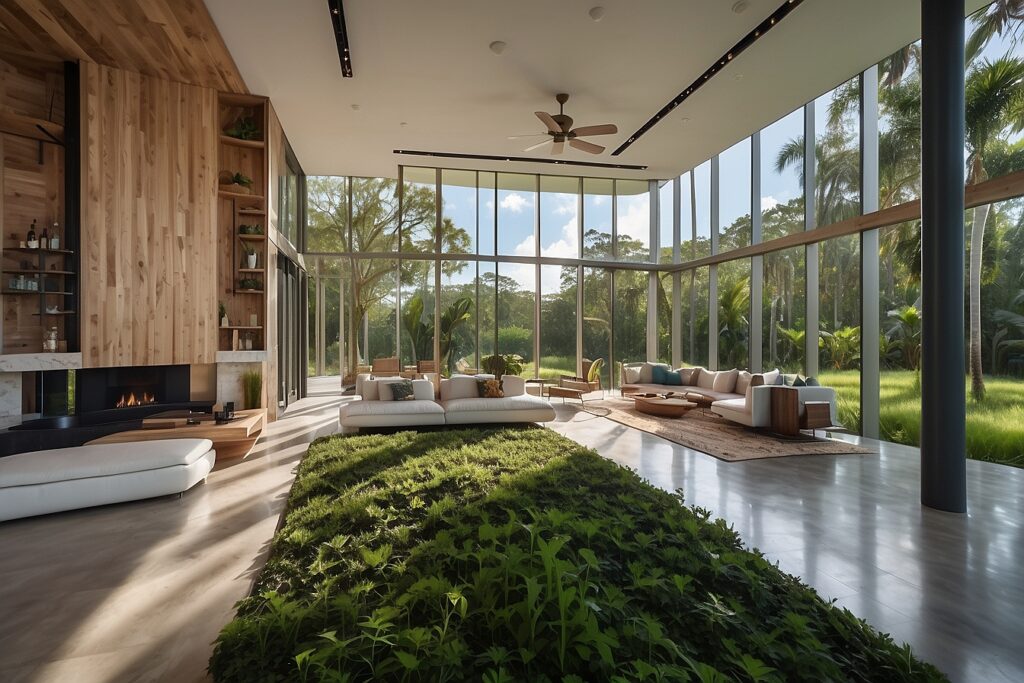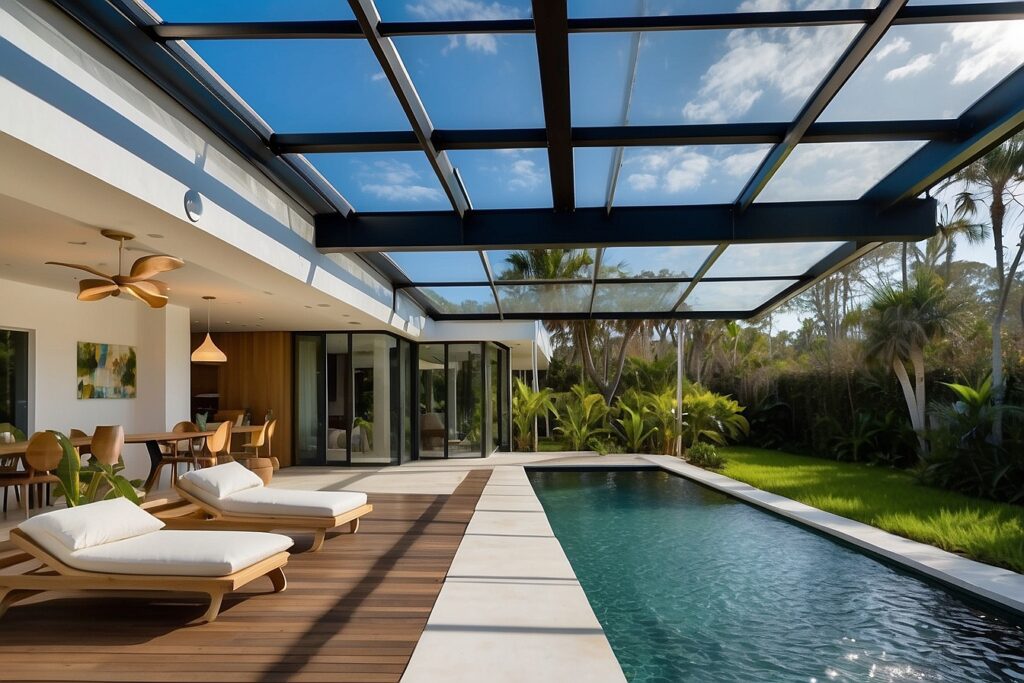As environmental awareness grows, many are channeling their commitment into creating green sanctuaries. Whether you’re an existing homeowner or on the cusp of purchasing, there’s a rising appeal to craft or modify dwellings that complement Mother Earth. This segment will guide you through the essentials of forging an eco-optimized home or retrofitting existing spaces with sustainable upgrades.

The Anatomy of an Eco-Home
Diving deeper than conventional construction, an eco-home champions reduced energy use, efficient waste management, and the incorporation of renewable resources. As custodians of such spaces, the objective becomes clear: diminish the environmental footprint through cutting-edge eco-technologies, power-efficient gadgets, sustainable building materials, and eco-aligned practices.
Essential Attributes of a Green Residence

Curious about what truly defines an environmentally-aligned dwelling? Here’s a snapshot of salient attributes to consider for those aspiring to create or remodel their homes in synchrony with nature.
Efficient Energy Utilization
One defining element of a green home is its focus on energy efficiency. Adopting energy-saving measures not only safeguards the environment from harmful emissions but also significantly trims your utility costs. This can be achieved through strategies such as sealing leaky ducts, integrating solar panels, opting for energy-conservative appliances, transitioning to LED lighting, and leveraging intelligent home devices like adaptive thermostats.
Nature’s Blueprint: Wooden Residences
Choosing wood as the foundational material, these homes present themselves as environmentally-conscious and budget-friendly options compared to the conventional brick and cement edifices. Not only are they forged from recyclable, decomposable materials, but wooden constructions also demand lesser energy, playing a dual role in carbon reduction by acting as carbon sinks.
Blueprints for a Sustainable Modern Home
Contemplating the construction of a green home? Here are essential aspects to ponder:
- Scale: Opting for a compact design can significantly lower your ecological impact, as smaller spaces typically demand less energy. Nonetheless, evaluate your specific requirements, especially if accommodating a family, to strike a balance between size and function.
- Building Materials: Kickstart your eco-journey by choosing sustainable construction materials. Think about integrating reclaimed wood and metal, bamboo, or modular concrete into your design.
- Thermal Regulation: Prioritize insulation to manage temperatures naturally. Consider wool-based insulation, an eco-friendly alternative to traditional fiberglass, and accentuate insulation efficiency with triple-glazed windows.
- Eco-Friendly Landscaping: Steer clear of sprawling lawns that guzzle water. Opt for earth-conscious landscaping that prioritizes water conservation, negates chemical inputs, and flourishes with plants resilient to water scarcity.
- Harnessing Solar Energy: Transitioning to solar panels minimizes dependency on conventional power while curbing greenhouse gas emissions, reinforcing your commitment to an eco-conscious abode.
Prioritizing Water Preservation
Water, an invaluable asset to our planet, warrants our utmost conservation efforts. Homes in sync with nature incorporate water-saving fixtures and systems that optimize water use, promote its reuse, cut energy consumption, and curtail expenditure. Simple shifts like introducing low-flow bathrooms fixtures – toilets, taps, and showers, play a pivotal role in slashing water wastage. Coupled with water-wise gardening, not only does one minimize water used for plants but also beautifies the surroundings with low-maintenance landscapes.
Waste Reduction Measures
Diminishing waste destined for landfills and lessening a structure’s ecological impact form another bedrock of eco-friendly living. From the construction perspective, builders can opt for materials with low environmental toll, like upcycled wood or modular concrete. Moreover, the assembly of parts off-site and final construction at the location can further curb excess waste. As inhabitants of these spaces, conscious choices like regular recycling, composting, and the preference for sustainable over disposable products (like glass over plastic bottles) are integral to this mission.
Diverse Faces of Green Living
Eco-friendly homes aren’t restricted to a single design mold. Ranging from classic designs revamped for energy efficiency to avant-garde architectural wonders, green homes are as varied as they are innovative. Here’s a peek into some variants:
Carbon-Neutral Residences
These dwellings stand out for their zero carbon emissions. Integral to their design are top-notch insulation measures and nearly impermeable seals on entry points like windows and doors, ensuring a minimal carbon footprint. Additionally, their sole dependence on electric power eliminates emissions typically associated with traditional sources like gas.
Turning Your Home Greener: Practical Steps
Owning a home doesn’t mean you can’t transition to eco-friendly living. Here are actionable steps to greenify your existing space:
- Lighting Transition: Switch to LED bulbs – they consume lesser energy and radiate less heat.
- Smart Climate Control: Introduce programmable thermostats to optimize energy use and curtail heating/cooling expenses.
- Harvest Rain: Set up a rainwater collection system, turning droplets into reusable water.
- Upgrade Appliances: Embrace energy-efficient gadgets, from refrigerators to washing machines.
- Composting: Transform waste into fertile compost, enriching your garden soil.
- 3R Philosophy: Integrate ‘Reduce, Reuse, recycle’ into your lifestyle, preserving energy and resources.
- Water Wisdom: Embed low-flow fixtures in bathrooms, ensuring minimized water consumption.
Modular Dwellings
These residences are crafted from elements assembled off-site and subsequently brought together at the chosen site. The construction of prefab homes, including modular variants, typically generates fewer by-products due to precise material estimations. Many homes now come equipped with robust sealing features, enhancing energy conservation and moderating heating and cooling costs.
Minimalist Living: The Tiny Home Movement
A growing number of people are gravitating towards the tiny home lifestyle, valuing efficiency and compactness in dwellings often under 600 square feet. Beyond their minimal energy needs, these homes are often constructed off-site, promoting judicious material utilization and diminished wastage.
Innovative Dwellings: Converted Container Homes
Marrying sustainability with creative construction, old steel shipping containers are ingeniously repurposed into distinct living spaces. These modular units offer flexibility, allowing for various configurations and expansions.
Nature-Inspired: Bioclimatic Residences
Harnessing natural elements to optimize energy efficiency, bioclimatic homes combine the nuances of their geographical setting with architectural finesse. Factors like placement, elevation, structure, and even hue are meticulously evaluated. These homes, crafted from sustainable materials and drawing upon renewable energy sources, integrate harmoniously with their surroundings, reducing energy expenditures.
Self-Sustaining Abodes: Passive Homes
Leveraging five pivotal strategies – sealed architecture, cutting-edge windows, premium insulation, eliminating thermal gaps, and advanced ventilation systems incorporating heat retrieval – such dwellings excel in energy conservation, possibly cutting energy costs up to 95%. A passive home intrinsically maintains its desired climate.
Natural Sanctuaries: Earth Domes
Built with sacks filled with elements like sand, clay, or gravel, earth domes represent the pinnacle of sustainable construction. With each bag layer fortified by barbed wire, these homes are not only eco-friendly but also thermally insulated and resilient against natural calamities.
Harnessing Sunlight: Solar-Paneled Abodes
Homes equipped with solar panels, be they affixed to roofs or anchored on poles, tap into the sun’s energy, transforming it into operational power. This shift towards solar can drastically diminish a home’s environmental impact, lessening or even bypassing conventional electricity sources.
Eco-Conscious Decisions
From the simple act of switching to LED lights to the more comprehensive choice of designing carbon-neutral homes, homeowners have the capacity to make eco-conscious decisions. At Mercury Insurance, we fervently support sustainable living. With our Green Home discounts on homeowner’s insurance, we offer an added 10% coverage for green alternatives after a covered incident.
For example, if an unexpected incident damages your carpet and you prefer a sustainable alternative, Homeowners Insurance promises to fund up to an additional 20% over the standard replacement cost, facilitating an environmentally conscious selection. This supplementary coverage also applies to household items, like heating/cooling systems or appliances, when opting for green substitutes.


